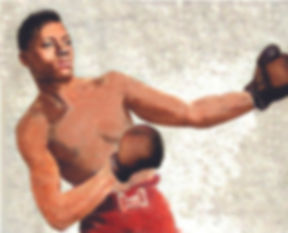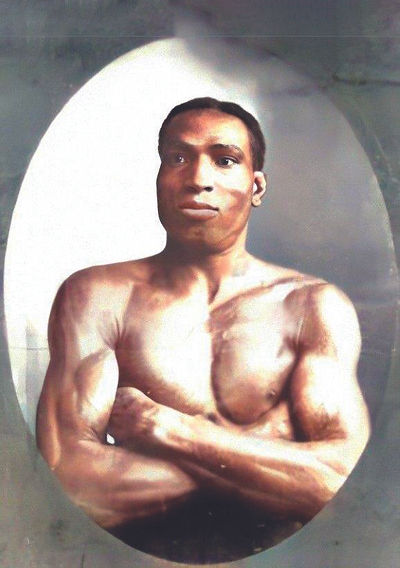
Winter 2024 Impressions Story
Hotelier and Boxing School Business Owner

By Chris Barnes and Jim Kane
“Simultaneously preserving the past and interrogating it” is the challenge that Linda C. Harris, the director and CEO of the Newark Museum of Art, recently spoke about regarding a building just restored by the Museum. In Ann Arbor, one building exemplifying this challenge, particularly to its African American residents and visitors, is the history embodied within the walls of the Kayser Block (built at 209-211North Fourth Avenue in 1899).While the importance of African American tenants and owners of the Kayser Block has been well documented, starting with the operation of the Foerster Hotel in 1905 through its purchase by The Colored Welfare League in 1921 and ultimately blossoming as an African American community center, there has been little mention of one of its most nationally significant occupants, Henry “Hank” Griffin (b. 1870 in Texas - d.1911 in Ann Arbor). Yet it is Griffin’s history as a boxer, and his operation of several commercial operations in the Kayser Building, that help us interrogate the contributions such buildings and occupants make to the enrichment of Ann Arbor.
News from Fistianna (the World of Boxing):
Hank Griffin Fought Some of the Best Boxers in History
The early part of Hank’s life is murky, but most historians state he was born in 1870 in Texas, possibly in Austin, likely to an African American father and a Native American mother. But by age 21, young Hank was in the ring in Los Angeles and earned a lifetime boxing record of what has been said to be 219 bouts, winning 103 by knockouts. Tracy Callis, historian for the International Boxing Research Organization, provides a list of over 50 of Hank’s bouts here. Griffin, in the peak of his career, was listed as tall (6” 1’ to 6”3’) and weighing in at 180 pounds. Observers describe his greatest boxing attributes as long arms, a strong punch, and good boxing skills, especially his ability to defend himself in the ring.
Boxing historians note that he was in the ring with some of the best fighters of the 1890’s and early 1900’s when he met Frank Childs, James J. Jeffries, Jack Johnson, Joe Kennedy, Denver Ed Martin, and Fred Russell. But it is Griffin’s slugfests with Jeffries and Johnson that garnered the most publicity at the time and later historical documentation


Future World Heavyweight Champion Opponents
Like many boxers of the day, and especially among African American boxers, life was difficult for all but a few atop the pinnacle of the sport. Hank Griffin’s experience was no different than that of many boxers in his fourteen year career. What distinguishes his boxing life is that he fought fights against two men who would go on to become World Heavyweight Champions, James J. Jeffries and Jack Johnson.
Some boxing reports have the first Griffin-Jeffries match as being in 1893, or possibly 1895. But it was the first match for Jeffries, who would go on to become the Heavyweight World Champion. And a tough one it was for both fighters with Jeffries coming from behind on points to score a knockout in the 14th round. The famed African American boxer and future World Heavyweight champion, Jack Johnson, would write in his 1927 autobiography: “In summing up my fights, throughout my career, there were none, even in the championship bouts, which were harder than those with Griffen (sic), and I believe that the greatest punishment I ever received in the ring was at the hands of Griffen (sic).”
The men fought three times between 1901 and 1902. And the brawls were legendary. Griffinwon the first bout in 20 rounds on points. The next two matches were draws, the second one going 15 rounds, and the final time in the ring the men faced each other, Griffin held Johnson to another draw for 20 rounds.
Retirement and Move to Ann Arbor
Life in the ring gave Griffin little chance for stability at home. He, his first wife Mattie Burleson, and their four children would often travel from boxing match to boxing match. The 1900 Census found the Griffin family of six living at 23½ Sixth St, near the corner with Market Street. The San Francisco Chronicle described the area as.... “San Francisco’s perennially down-on-its-luck ...street.” Looking to settle elsewhere, Griffin and his wife opened a boarding house for fighters, with his wife cooking the meals, in 1903 in Monrovia, California. His marriage and the business didn’t last, but Griffin had his first opportunity to be an entrepreneur and develop skills that would bode well for his post-boxing life. He soon joined a traveling boxing/sparring show, called The Honest Blacksmith, with the famous Australian boxer Bob Fitzsimmons. While on the road, he met and married, in Windsor, Canada, his second wife, Eva Johnson, from Albion, Michigan. Eva’s mother, Hannah Foster Johnson, and father, Samuel Johnson, likely traveled north with the Albion Rifle Rangers after they were stationed and fought in Louisiana during the Civil War. Samuel Johnson was described in the Veteran’s Schedule for one Census Count as having lost an eye in the war. Harrison Soule was the Captain of the Albion Rifle Rangers, which would morph into Company I of the 6th Michigan Infantry Volunteers. He would later go on to become the Treasurer of the University of Michigan and Vice President of the First National Bank of Ann Arbor.
As Griffin’s time in the ring came to an end (his last fight is listed as being in July 1904 or June 1905), he had to seek another business model to take care of his family. Together with his new wife and two of his four children, Griffin made a home in Jackson, Michigan, for several years before moving to Ann Arbor. While in Jackson, he operated a boxing school, a skill he’d further develop during his time in Ann Arbor.



The local paper had a large headline trumpeting Griffin’s arrival in Ann Arbor, stating that..... ”one of the most noted pugilists of the country is here and is opening up the Foerster hotel on Fourth Ave”. But most of the article focused on Griffin’s boxing prowess, claiming that he was the man with the longest reach and that in 76 fights, he’d never been knocked out. Early Black visitors to Ann Arbor would have known that reports that the Foerster Hotel was “under colored management” was a clear message that rooms would be available to them, unlike at other hotels in town. And Griffin’s high profile would be a continued signal that African Americans would still find a place to stay in what was to be transformed into the Griffin Hotel.
Griffin and his family would settle into the Kayser Block and make it their home. Soon after opening the hotel, Griffin would expand his business to include a pool hall and a boxing academy, offering training classes to all, including students at the University of Michigan who came to train under one of the ring’s great boxers.
Life in Ann Arbor must have been a different pace for a man who’d traveled the United States and fought for a living. Contemporary accounts of the Griffins in Ann Arbor note the usual sorts of challenges local businesses face, as well aseveryday occurrences like runaway dogs and a baseball game between the African American men who were married and those who weren’t. But the lure of the boxing world still loomed large in Griffin’s life.
The Detroit papers, in particular, liked to call on Griffin for comments on upcoming matches. For example, on April 30, 1910, The Detroit Evening News gave Griffin plenty of space to explain the dynamics that might occur in an upcoming fight between James J. Jeffries and a Jack Johnson. In the article, Griffin cautioned.....”anyone betting very much either way on the big fight next July is foolish”.
Keeping his foot in the ring, Griffin promoted a number of boxing exhibitions in the area, including bouts of four rounds in Milan’s Opera House in May 1910, and a notable three-round exhibition with one of Griffin’s boxing pupils, a student from the University of Michigan, in March 1911. This was to be one of Griffin’s last times in the ring. There was another five-round exhibition that was reported on in the Detroit Free Press before the same paper, on May 3, 1911, wrote that the .....”heavyweight pugilist took the count for the last time early today succumbing to a protracted attack of typhoid fever”.
A fitting tribute was written about him in the local paper.....”Griffin has the respect of many people in his city, both of his own race and among white people, for he was always courteous and obliging and he had an excellent reputation in every way”.
The greatest boxer to ever call Ann Arbor home was laid to rest in an unmarked grave in Fairview Cemetery.
About the Authors
Chris Barnes is a retired Correctional Supervisor in DC, a boxing aficionado and personal trainer. Jim Kane is proud to have four great-great-grandparents, from the Ritz and Lucas families, who lived in Ann Arbor. The authors would like to thank the International Boxing Research Organization for their help with this article, in particular Dan Cuoco, Tracy Callis, Henry Hascup, and Adam Pollack. And thanks to Renee Inayoshi for her insights into Eva Johnson and her family history, Marguerite Little, Josh Dukes, Joe Findlay and Rebecca Campbell.
If you have any questions, comments or feedback,please email wchs-1000@ameritech.net. THANK YOU.